The family Caryophyllaceae is a fairly large group of plants that includes quite a range of familiar species, such as pinks, campions and chickweeds, as well as some perhaps not so familiar, such as pearlworts and knawels. As this is such a large group, this page will help narrow your search, once you have arrived here from the flower colour pages.
With such a variable family, it is difficult to make generalisations that define the group. Most species have flowers with five (sometimes four) petals that are white or shades of pink or red. Members of the subfamily containing the campions, catchflies and pinks, tend to be taller-growing species with mostly simple leaves and relatively showy flowers. Members of the chickweed and sandwort group generally have white, five-petalled flowers, though the petals are often so deeply cleft as to sometimes give the appearance of having 10 petals. The third group, containing the knawels and pearlworts are mostly ground-hugging, creeping plants, often with petalless, easily-overlooked flowers and some could even be mistaken for mosses or liverworts.
At this stage, be sure to read the texts below, as they contain identification information that may not be visible in the photographs; clicking to the next stage will help you get to the exact species.
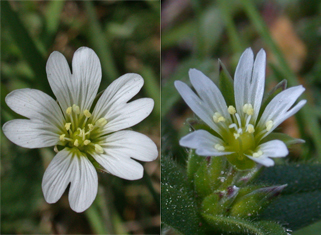 |
Mouse-ears
Generally small to very small, low-growing species that require lying on the ground to study! Petals notched or, more often, deeply cleft. Differ from other members of this family by their overall very hairy stems and leaves. |
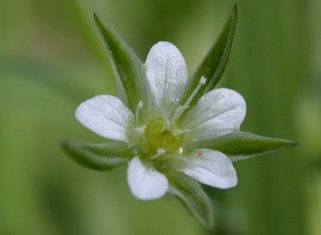 |
Sandworts
Rather small, low-growing species of woodland or open, often bare or disturbed ground. Leaves may be oval in outline, or fine and needle-like. Flowers less than 1cm across, petals rounded, not notched, usually shorter than, or equal to, sepals. |
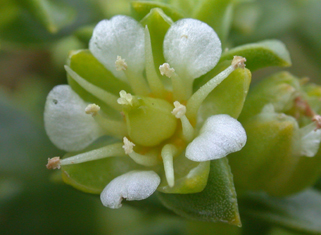 |
Sea Sandwort
Low, ground-hugging plants with thickly fleshy leaves. Flowers followed by bright, greenish-yellow, rounded seed capsules. Most likely to be found on shingle beaches. |
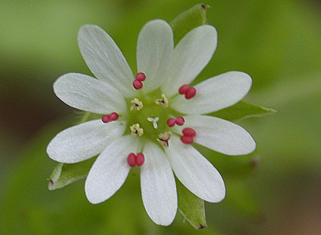 |
Chickweeds
Mostly low-growing (oocasionally taller), 'weedy' plants of urban and disturbed ground but also in woodland. Leaves usually broadly ovate, petals deeply cleft so as to often make the five petals appear like 10 (check carefully!). Note that some species rarely have petals and the flowers may self-pollinate without opening, but such plants resemble other chickweeds in their leaves and growth style. |
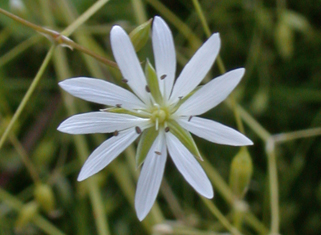 |
Stitchworts
Flowers with five petals that are very deeply cut, almost to the base. Plants slender, often straggling through vegetation; leaves narrow, stems often four-sided. Plants of rough, grassy places and often in wetlands. |
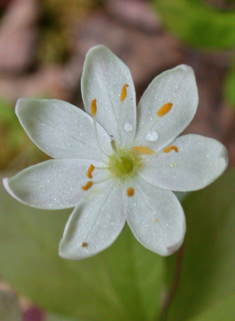 |
Chickweed-wintergreen
An unrelated plant that looks similar to some of the chickweeds but which is related to the pimpernels. Flowers may have five petals but more often have seven or even nine. Flowers are solitary at the top of the stem and have a whorl of five or six leaves beneath them (a northern species that is probably extinct in our region). |
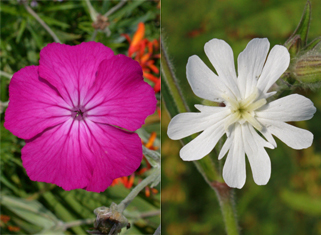 |
Campions & Catchflies
The tallest and showiest members of the family are in this group, though there are also some small species. Flowers either white or various shades of (usually bright) pink or red, carried on longish stems above basal leaves; leaves usual simple, obovate or lance-shaped. Five petals which may be rounded but are usually notched or divided at the tip. Many species have a noticeably swollen calyx at the back of the flower which is often hairy and swells even more in fruit. Plants of open, disturbed ground, heathland or woodland. |
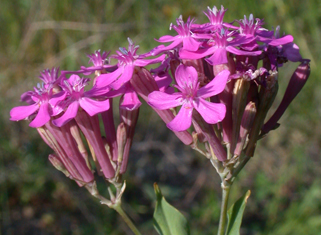 |
Campions & Catchflies
Some catchflies and campions have tigher heads of flowers with tubular bases. These may be red/pink or white and are often quite showy and obvious. These are mostly garden escapes and, as such, could be found in a range of habitats, but most likely would occur on roadsides, waste ground or urban situations. |
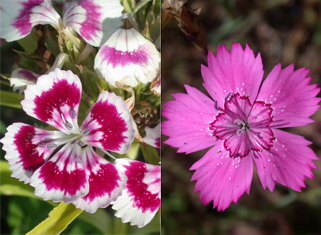 |
Pinks
The 'pinks' include carnations, Sweet-William and related species in the genus Dianthus. This is a rather variable bunch with some being relatively tall with simple, lanceolate leaves, while others are spreading and diffuse. All tend to have deeply incised petal tips, giving the flowers a slightly ragged look, while most have intricate pale spots and dark, wavy lines on the petals. |
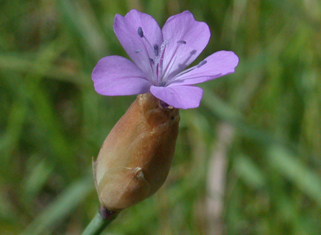 |
Pinks
The 'pinks' in the genus Petrorhagia are distinctive in their combination of small flowers with only slightly-notched petals, above a swollen flower base with tough, stiffened bracts. These bracts conceal a number of flowers, each of which opens one at a time in turn, causing the base of the flower to swell ever more as the spent flowers expand to form seeds. Plants small with lanceolate leaves and flowers carried on slender stems. Rare. |
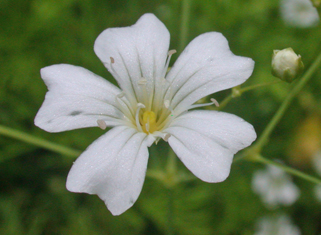 |
Baby's-breaths
Occasionally found as garden escapes, these are plants with small but showy white flowers that are typically carried in spreading, many-branched flowerheads, rather than on a single spike. Leaves often bluish-green in colour. |
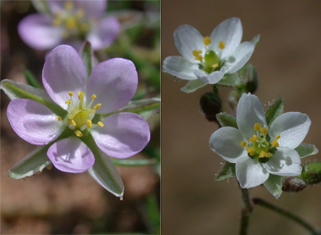 |
Spurreys
Flowers with five petals that are round-tipped and not notched. Petals may be white or pink. Plants are either low-growing, often ground-hugging plants of saltmarsh or sandy places, or taller arable weeds. Told from other members of the family by the combination of five-petalled flowers and needle-like, fleshy leaves. |
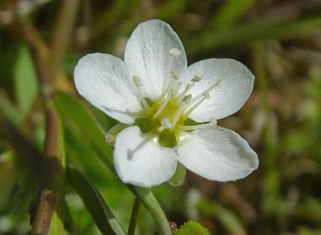 |
Larger Pearlworts
Plants small, often spreading like mosses; flowers with five petals. Leaves needle-like. Plants of bare ground in fields, coastal or urban habitats. |
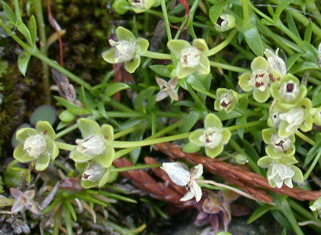 |
Smaller Pearlworts
Plants tiny, often spreading like mosses; flowers with no petals but four open sepals. Leaves needle-like. Plants of bare ground in fields, coastal or urban habitats. Some species are very common as weeds of paved areas. |
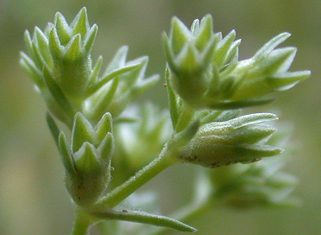 |
Knawels
Small, low-growing plants with needle-like leaves that are easily overlooked. Inconspicuous flowers with spikey, white-edged, greenish sepals and no petals. Plants of open, usually sandy ground. |
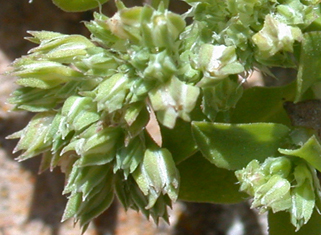 |
Four-leaved Allseed
Small, prostrate plants that are easily overlooked and differ from knawels by their broad, rounded leaves. Inconspicuous flowers with spikey, white-edged, greenish sepals. Rare plants of open, usually sandy ground. |
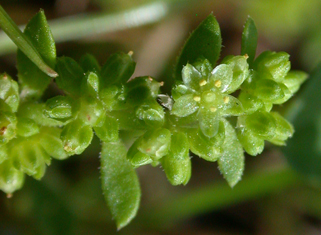 |
Ruptureworts
Prostrate plants with small, ovate leaves and inconspicuous flowers, the five dull petals shorter than the sepals. Rare plants of tracksides and disturbed ground. |